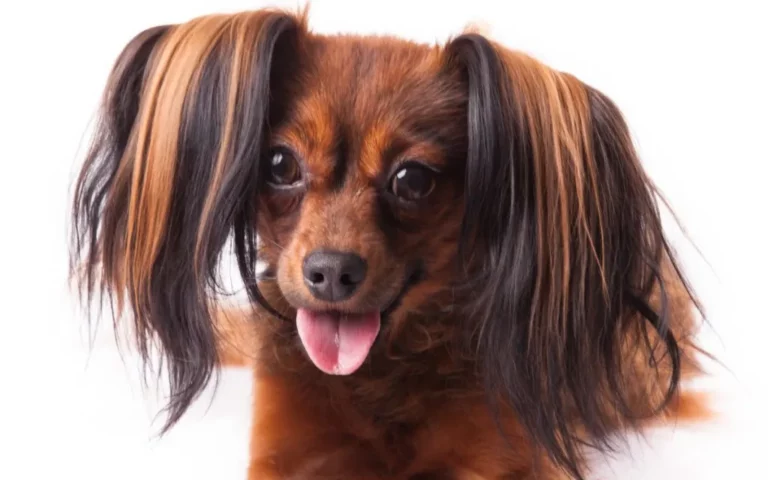Russian Toy Dog Breed Information
The Russian Toy is a small dog breed known for its charm and fascinating past. Once bred for the Russian elite, they have become beloved pets worldwide. Their playful spirit and small size make them perfect for family life.
The Russian Toy is both graceful and lively. Thanks to selective breeding, you can find them with smooth or long coats, showing their varied looks.
When discussing their personality, care needs, and health, it’s clear they are a significant part of the dog world. Conversations about the Russian Toy help owners and enthusiasts appreciate the deep connection between people and dogs.
Key Takeaways
- Russian Toys were once exclusive to Russian nobility.
- These dogs are known for their playful demeanor and adaptability.
- They come in varied coat types, thanks to breeding.
Russian Toys, historically exclusive to the aristocracy, now charm families globally. Their adaptability and playful nature make them ideal companions. With a choice between smooth or long coats, Russian Toys offer diverse appearances.
Quick Facts
The Russian Toy is a small yet elegant dog breed that stands 8-11 inches tall and doesn’t weigh over 6.5 pounds. These dogs are known for their keen minds and lively spirit, typical features of the Toy Group. Russian Toys are among the tiniest breeds, and they generally live for 12-14 years, showcasing a cheerful disposition and sharp wit. They conform to breed standards with two types of coats: long-haired and short-haired, and they come in colors like black and tan, as well as various shades of red and brown sable.
Early socialization and ongoing training are crucial for this breed due to their strong sense of territory. Caring for a Russian Toy involves regular brushing, daily exercise, attentive dental hygiene, and periodic vet visits to ensure they remain healthy. These dogs thrive with owners who understand their need for companionship and activity.
Russian Toy Dog Breed Pictures
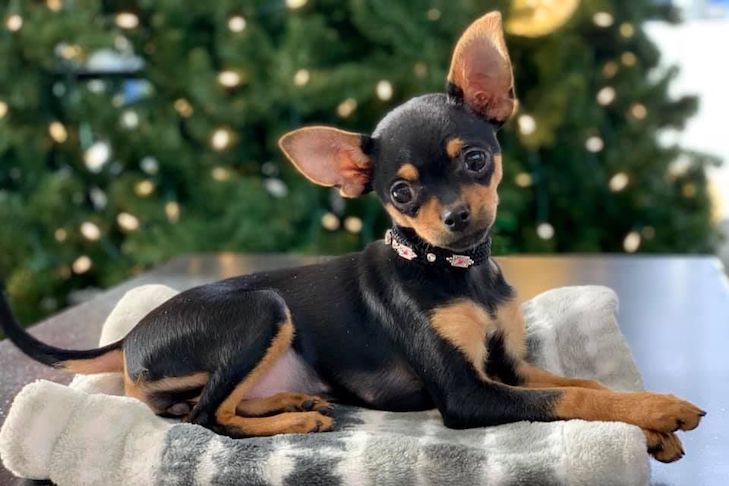
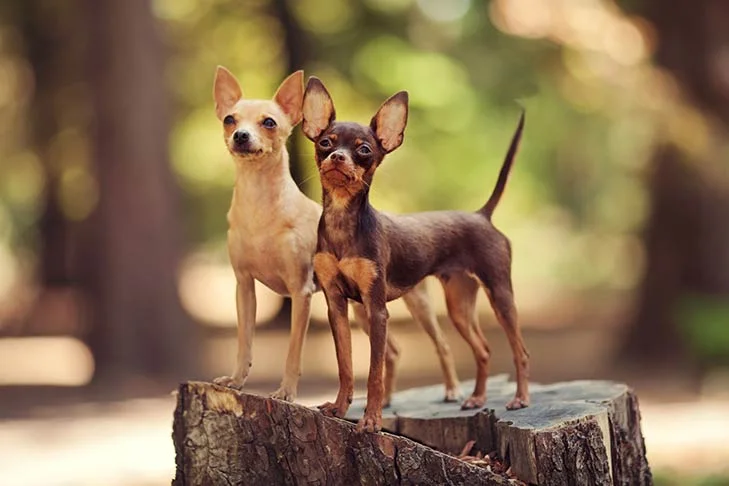
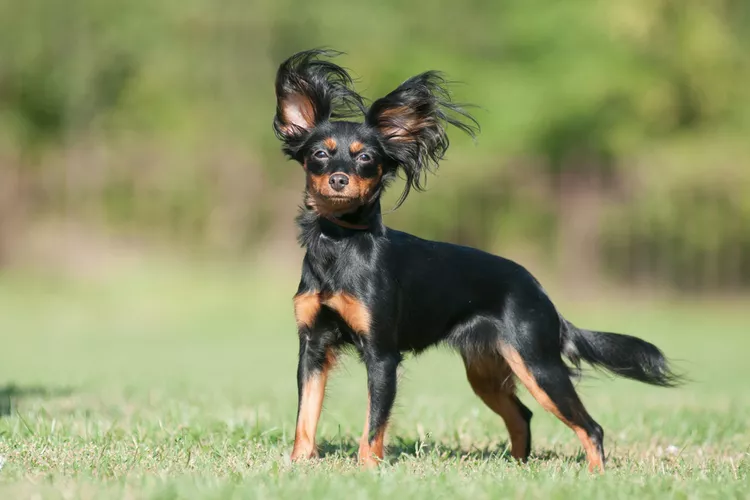
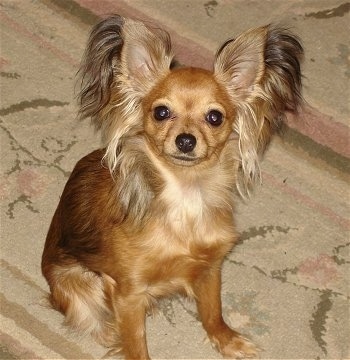
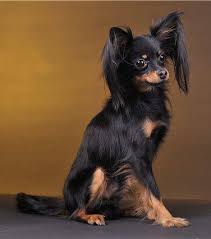
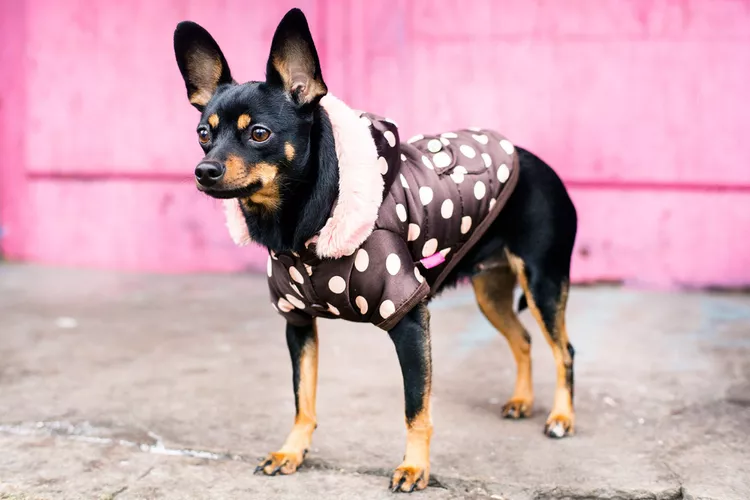
Overview
Having established the essential characteristics and care requirements of the Russian Toy, let’s explore a more comprehensive overview of this miniature and spirited breed. As a member of the Toy Group, the Russian Toy stands out due to its petite stature, typically reaching only 8-11 inches in height and weighing up to 6.5 pounds. This breed has a life expectancy of 12-14 years, showcasing its small elegant form, lively nature, and sharp intelligence—these traits, combined with a strong desire to please, make the Russian Toy a delightful companion.
While they are low-maintenance in grooming, with both long-haired and smooth-haired varieties, they thrive in environments without the boisterousness of large dogs or tiny children. The breed’s health concerns are not widely known, but their small size may predispose them to dental issues and bone fractures, necessitating attentive veterinary care.
Russian Toys are active and cheerful despite their size, bonding closely with their families, displaying cautiousness around strangers, and occasionally showing a protective streak. Early socialization is essential to ensure they are well-adjusted companions.
Breed Characteristics
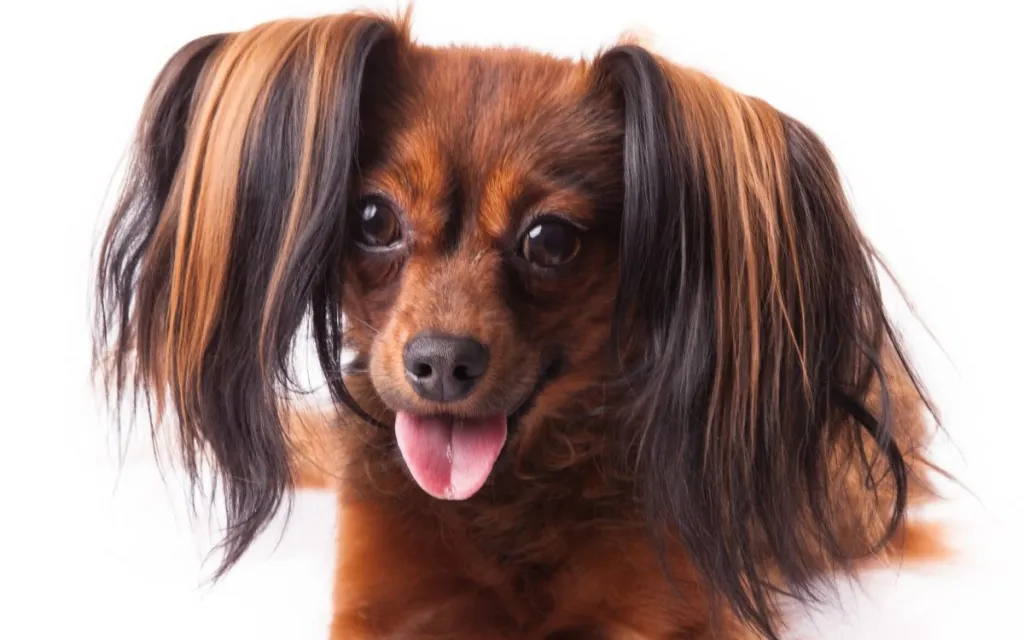
The Russian Toy dogs are known for their elegant and agile build, with lean bodies supported by lengthy, slender legs. Their eye-catching coat colors range from black and tan to shades of red and brown sable. These dogs have large eyes that show their intelligent and inquisitive nature. The long-haired variety, in particular, showcases a coat that needs regular care to look luxurious. Russian Toys are happy, energetic pets that form strong attachments with their owners.
| Aspect | Long-Haired Variety | Smooth-Haired Variety |
|---|---|---|
| Grooming | Needs regular brushing | It also comes in blue and tan |
| Coat Colors | Black and tan, shades of sable | It needs to be walked every day |
| Exercise | It also requires daily walks | Also requires daily walks |
Russian Toys are easy to train and are devoted companions. They also serve as alert little protectors for the home.
The breed’s characteristics include those large, expressive eyes that reveal a dog’s intelligence and interest in their surroundings. The long-haired type of this breed stands out with a coat that demands consistent grooming to keep its refined look. These dogs are lively joyful, and develop a deep connection with their human families.
Russian Toys are not only easy to train, but they’re also very loyal, making them fantastic pets and vigilant little watchdogs.
Origins and Evolution
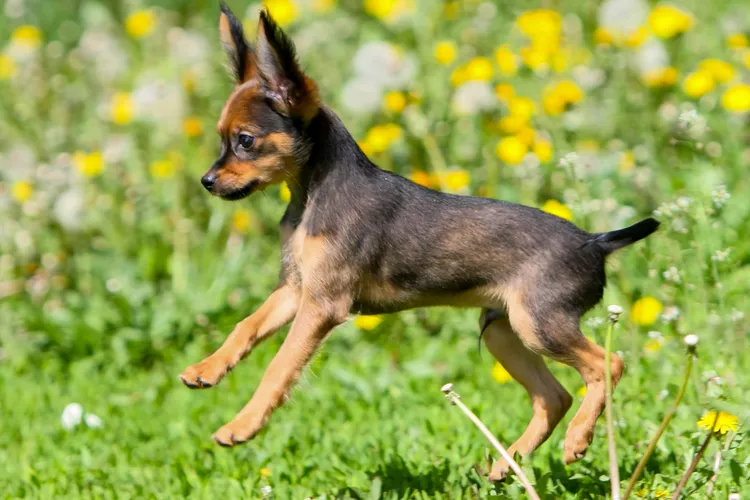
The Russian Toy has roots entwined with Russian history, bred initially as pets for the aristocracy. Several key phases mark their story:
- Originating from European toy breeds, they quickly became prized by Russian nobility.
- After the revolution, their numbers dwindled, but they saw a resurgence in popularity in the 1900s.
- They gained international fame, with the American Kennel Club’s Foundation Stock Service acknowledging them.
Each stage of the Russian Toy’s development shows the impact of societal shifts and selective breeding.
These factors turned the breed into the endearing pet we adore today.
Ancestral Russian Roots
The Russian Toy is a breed with a storied past that returns to the opulent gatherings of Russia’s imperial era. The breed has roots in small European toy breeds and has become a beloved and tiny canine breed globally. These dogs were once called English Toy Terriers and were popular among Russian nobles for their refined look and lively personality. They were so cherished that they kept company with Russian royalty.
The upheaval of 1917 was critical for the breed, leading to a name change and official acknowledgment by the Russian Kennel Club in 1958. This change highlights the breed’s ability to endure and adapt, making it popular among dog lovers everywhere.
Breed Development Stages
Reflecting on its noble origins, the Russian Toy has undergone significant changes from its early days as an aristocratic emblem to its present role as a beloved pet. The breed’s history dates back to the 1700s and has adapted through various societal shifts.
Initially known as the English Toy Terriers, the upheaval of the Russian Revolution led to the emergence of a distinct breed, now known as the Russian Toy Terrier. This breed split into two forms: the long-haired and the short-haired, descendants of small European toy breeds.
Unfortunately, the Russian Toy’s population dwindled during political strife, nearly reaching extinction. Thanks to concerted breeding efforts, the breed has returned, retaining its energetic and resilient characteristics despite its small size.
AKC Recognition Journey
The Russian Toy Terrier has made its way up to being recognized by the American Kennel Club (AKC). With a proud heritage, this small dog has evolved from its English beginnings to become a distinct breed in Russia. Originally known as the English Toy Terrier, it was after the significant changes in Russia that it got its new name, Russian Toy Terrier.
The Russian Kennel Club gave its official nod to the breed in 1958, marking a turning point in its history and paving the way for it to become known worldwide. The Russian Toy Terrier, which comes in both long-haired and short-haired versions, has caught the eye of many in the AKC companion events.
The hard work of the Russian Toy Club has played a vital role in moving the breed closer to AKC recognition. This reflects not only the breed’s rich background but also its potential within the American Kennel Club.
Stature and Build
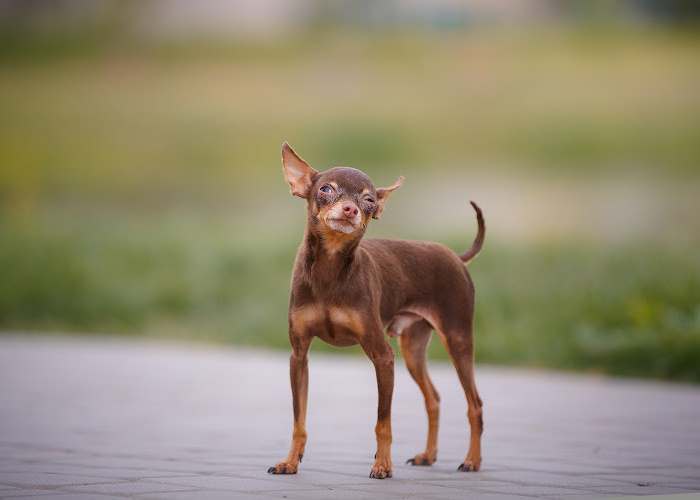
The Russian Toy dog is small and sturdy, with traits that make it easily recognizable and agile. It’s essential to consider these aspects of the Russian Toy for a full appreciation of the breed:
- This breed’s delicate bone structure and lightweight body give it impressive agility and an energetic personality.
- Russian Toys have two types of coats, each needing their grooming methods to keep their sophisticated appearance.
- No matter the individual dog, Russian Toys are known for their attentive look, with big eyes and large, triangular ears that reflect their lively and observant character.
These characteristics are crucial to understanding Russian Toys’ abilities and care requirements.
Size and Proportion
The Russian Toy stands out with its tiny stature, reaching 8-11 inches and tipping the scales at barely 6.5 pounds. This breed embodies the classic toy breed’s small size and fragile structure.
Among the tiniest dogs, the Russian Toy sports long legs that lend a sophisticated outline and a graceful look. These little dogs may have slim bones and svelte muscles but are energetic and quick on their feet. Their dimensions and build are unique traits and enhance their lively antics and smooth motion.
Owners must recognize their Russian toys’ physical traits alongside their energetic personality. Giving these delightful, tiny friends the care and attention they need is essential.
Coat and Grooming
Owners of Russian Toys need to pay close attention to their dog’s grooming needs to keep them healthy and looking their best. The smooth-haired variety is low maintenance, but don’t ignore it completely.
Meanwhile, the long-haired Russian Toys require regular grooming. Their longer fur can get matted, so they use a bristle brush to keep their coat shiny and detangle the fur around their ears, a signature feature of the breed.
Even though they’re small, Russian Toys should get daily exercise and play to stay in shape. Along with physical activity, consistent grooming is vital to maintaining their polished look.
Common Physical Traits
Russian Toys are known for their small size and elegant shape, usually weighing 3 to 6 pounds and standing up to 11 inches tall. These dogs combine a look of nobility with strength, sporting long legs and a slender frame that showcases their energetic nature.
They come in two coat types: the smooth-coated and the long-haired, both of which are easy to maintain and come in various colors. Their large, almond-shaped eyes and high-set, triangular ears give them a unique appearance.
Russian Toys are surprisingly sturdy for their size and have a regal look that makes them appealing as pets for those who appreciate a small yet majestic dog.
Activity and Exercise
Russian Toys are small dogs that need regular activity to stay fit and healthy. They are part of the Toy Group and have delicate bones and muscles that benefit from consistent, gentle exercise. They are full of life and enjoy participating in dog sports, which helps their physical and mental health.
These little dogs love to play and learn and need both to be happy. Training and games keep them active and in good shape. It’s up to breeders and dog owners to make sure Russian Toys get enough exercise to match their lively personalities.
Russian Toys are known for their energy and agility. They flourish when provided with the right amount of play and mental stimulation. Ensuring these active dogs engage in fun activities helps maintain their health and happiness.
Health Considerations
The small size and delicate bones of the Russian Toy mean they must be handled with care to prevent injuries. They also need special health care for common issues like knee dislocation and dental problems.
These dogs weigh up to 6.5 pounds, making them particularly prone to accidental injury. Knee dislocation, or patellar luxation, is a frequent problem in small dogs and can impact the life quality of a Russian Toy. Regular vet check-ups are necessary to keep their joints healthy.
Proper dental hygiene is critical for these dogs because they often have oral health issues. It’s also essential for them to get the right amount of exercise. Too much can cause harm, and too little can lead to obesity, especially given their fast metabolism and petite frame.
Long-haired Russian Toys might need more brushing to avoid skin problems depending on their coat type.
Temperament Traits
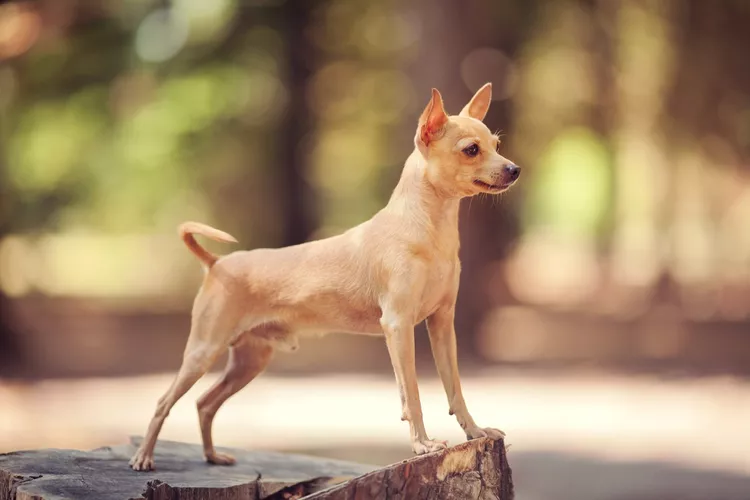
The Russian Toy dog breed is a loving companion and a vigilant guardian, reflecting its dual-purpose history. This breed’s personality is made up of a few standout traits:
The Russian Toy thrives on interaction and needs consistent socializing with people and other pets. This helps them become well-behaved and friendly.
Their smartness and desire to please make them quick learners means training can satisfy the owner and the pet.
These dogs are naturally attentive and protective, so they need the proper training to handle new situations properly.
Lively and Devoted Companions
Russian Toy dogs are known for their lively and affectionate nature. They build strong bonds with their owners and are energetic and attentive pets. These dogs are happiest when they’re around their family members.
The Russian Toy Terrier may act shy around new people, so getting them used to different social situations early on is essential. They make excellent watchdogs and promptly inform their owners if something’s up.
Their smarts become apparent when you train them; they love learning and making their owners happy. Russian Toys are also fiercely loyal and often show a protective side towards their family.
Exposure to various people and environments from a young age is critical to helping them become well-rounded and friendly dogs.
Social Interaction Needs
Russian Toy dogs are known for needing constant companionship and engaging in activities with their owners. These energetic dogs build strong connections with their human families, which brings them happiness and a sense of purpose.
Even though they are small, Russian Toys are vigilant and make good guard dogs due to their alert nature. They show love to people they know, but they may act cautious around new people, which shows why it’s essential to socialize them well. This helps build their confidence and makes them more well-adjusted.
Russian Toys are intelligent and quick to learn, so they can fit into different social situations if they start learning when they are young. This includes getting along with kids, other pets, and dogs.
Training and Intelligence
Understanding how Russian Toy dogs interact with others is critical to realizing their quick and alert minds, which is vital for practical training and making the most of their intelligence. These small dogs are full of energy and happiness, making them eager to please when being trained. Their sharp minds and willingness to learn make Russian Toys great for many dog activities, showing their adaptability.
Russian Toys were once pets for Russian nobility, and this history has given them a loyal and loving nature. They are also very active and do well with engaging training programs. It’s essential to start socializing them early and use patient, consistent training to manage their tendency to guard their territory so they become well-behaved companions.
Russian Toys are known for their loyal nature and active personality, which come from their past as noble companions. They must start learning to socialize and train appropriately from a young age. This way, they can overcome their instinct to guard their space and become well-mannered family members.
Alertness and Protective Nature
Russian Toy dogs are known for their alertness and protective behaviors, making them excellent watchdogs. They are always on the lookout, ready to warn their owners of anything unusual or potentially threatening.
This small breed is not just watchful; it’s also incredibly dedicated to its family, showing a strong protective instinct. To prevent their natural defensive behavior from becoming aggressive, it’s essential to socialize them early.
Consistent training takes advantage of their intelligence and agility, improving their natural guarding abilities. Russian Toys tend to bark a lot, which helps them in their role as watchdogs, as they quickly notify their owners of any strange happenings, increasing the safety of their home.
Exercise Requirements
Russian Toys, although small, need regular exercise to stay healthy and happy. Their alert and protective instincts, paired with their lively energy, mean daily walks and playtime are essential. These activities are not just good for their body but also their sharp minds.
Engaging play and ongoing training keep their active brains busy and help prevent boredom. Starting socialization and training early is essential for their development into friendly pets. Russian Toys are intelligent and quick, which makes them great at dog sports.
When planning their exercise, remember they can have joint issues like patellar luxation, so choose activities that are kind to their joints.
Common Ailments and Lifespan
When considering the health and longevity of the Russian Toy breed, prospective owners should be aware of specific breed-specific health concerns. These include:
- Dental problems, expected due to their small jaw size, can lead to more severe health issues if not addressed.
- Patellar luxation is a genetic condition affecting the knee joint that can impair mobility.
- A propensity for bone fractures necessitates careful handling and a safe living environment to prevent accidents.
Owners should prioritize preventative care and regular veterinary check-ups to ensure their Russian Toy enjoys an entire and healthy lifespan.
Typical Health Issues
The Russian Toy typically enjoys a lifespan of 12 to 14 years but is prone to specific health problems. This breed often faces dental issues, which are critical to managing due to their small mouths leading to crowded teeth and difficulties with baby teeth not falling out as they should. This can increase the chances of gum disease.
Patellar luxation is another issue, where the kneecap pops out of place, which can be painful and problematic for these dogs. Their small size also makes them more likely to suffer from bone fractures after minor mishaps. Owners need to create a safe living space to prevent such injuries.
Regular visits to the vet can help keep these health issues in check and maintain the breed’s health.
Expected Longevity
Understanding the common health issues of the Russian Toy can help owners extend their pets’ lives, which usually last between 12 to 14 years. Dental problems are common in this breed, so regular teeth cleaning is necessary to prevent decay and gum disease.
Because of their size, Russian Toys might also experience patellar luxation, meaning their kneecaps can slip out of place. They are also at risk for bone fractures. Regular vet visits are crucial, especially since there isn’t much information on their health outside Russia.
The lifespan of the Russian Toy shows how tough they are, but it also highlights the need for careful health care to keep them thriving.
Preventative Care Tips
Taking care of Russian Toy Terriers involves regular health maintenance to prevent common problems such as dental issues and the risk of broken bones. Brushing their teeth regularly to avoid tooth and gum diseases is essential.
Providing a secure area for them to play in helps prevent injuries since these small dogs can easily get hurt. To keep them healthy, watch for signs of patellar luxation, a common issue in small dog breeds.
Unlike some breeds, Russian Toy Terriers don’t have their tails docked, so keeping their natural tails in good condition is essential. Early socialization, plenty of exercise, and a proper diet are critical to their overall health and can lead to a longer life for these tiny companions.
Grooming and Maintenance
Taking care of a Russian Toy’s unique look and well-being means sticking to a grooming routine made just for them. Key points include:
- Regular brushing is necessary for the long-coated variety to avoid tangles and smooth fur.
- Keeping their tiny feet in shape also means sticking to a nail-trimming routine to stop nails from becoming too long, which can cause pain.
Good dental care is also critical for Russian Toys because they often have teeth problems. Regular cleanings are necessary to keep their mouth healthy.
This dedicated care plan helps Russian Toys stay both beautiful and healthy.
Coat Care Essentials
Taking care of a Russian Toy’s coat is crucial, especially for those with long hair. Long-haired Russian Toys must be brushed often to avoid tangles and keep their fur good-looking. Short-haired ones need a quick brush now to stay shiny. A bath every month is good for bimonthly bathing skin and fur clean.
It’s also vital to look after the Russian Toy’s teeth because they can have dental problems. Cleaning their teeth regularly helps prevent these issues. Regular vet visits are essential for their health, as are daily walks to help them stay fit and happy.
Nail Trimming Schedule
Trimming your Russian Toy’s nails every two to four weeks is crucial. This regular maintenance helps prevent pain and health issues related to overgrown nails, such as patellar luxation, a knee problem common in small dog breeds.
Sticking to a nail care routine is essential to keep your Russian Toy’s paws in shape. Use the right tools – small breed nail clippers – for a painless, clean cut. Be careful to avoid cutting into the nails and trimming jails.
If you’re not confident about trimming nails, seek advice from a groomer or vet. They can show you the proper way to care for your dog’s nails and even provide a demonstration.
Dental Hygiene Practices
Taking care of your Russian Toy’s teeth is just as important as keeping them grooming their furly and is crucial to ward off dental diseases, especially for those with long hair.
If you notice your dog has bad breath, discolored teeth, or shows discomfort while eating, it’s time to see the vet. Use toothpaste made for dogs and a toothbrush that fits their small mouth to keep their teeth clean.
Dental chews and toys designed to clean teeth can also help to reduce tartar buildup. For a thorough approach to dental health, have your dog’s teeth regularly checked by the vet.
Ear Cleaning Routine
Keeping your Russian Toy’s ears healthy is vital, so a regular and careful cleaning routine is a must to avoid infections and catch any problems like irritation or pests quickly.
Since Russian Toys have prominent, upright ears, it’s essential to check them often to keep them clean and healthy. Examine your dog’s ears weekly for wax, dirt, or unusual fluids.
When cleaning, choose an ear solution recommended by vets and use a cotton ball or round pad to clean the outer part of the ear canal gently. Be careful not to poke deep into the ear and avoid cotton swabs, which could harm the delicate inner ear.
Reward your dog with lots of praise and a treat after cleaning to make it a good experience.
Keeping up with ear care will keep your pet free of pain and happy.
Exercise for Coat Health
Regular grooming is vital to maintaining the beautiful coat of the long-haired Russian Toy. The short-haired variety needs less grooming, but it should still be done regularly.
Exercise boosts coat health by improving blood flow, making the fur look better. The Russian Toy’s need for moderate exercise fits well with its grooming needs, helping to keep the dog healthy and its coat shiny.
Taking care of the dog’s teeth is also important because dental problems affect its overall health and, in turn, its coat.
It’s vital to have the Russian Toy checked by a vet often to ensure its coat and skin are healthy and to catch any issues early.
Nutritional Requirements
Their small size and active nature influence the dietary needs of the Russian Toy Terrier. To meet their unique requirements, pet owners should:
- Provide a well-rounded diet with vital nutrients specifically designed for toy breeds.
- Feed them more often to prevent low blood sugar due to their petite build.
- Include high-protein foods in their meals as advised by a vet.
A proper diet is essential to keep a Russian Toy Terrier healthy and energetic.
Balanced Diet Essentials
For Russian Toys’ health and energy, feeding them a balanced mix of proteins, fats, carbs, and other nutrients is crucial. Their small size and high energy mean they need a diet specific to their needs.
Proteins are essential for maintaining muscles, and healthy fats help with energy levels and vitamin absorption. Carbs are necessary for sustained energy, and fiber keeps their digestive system running smoothly. Watching their portions can help avoid weight gain, which smaller dogs can be prone to.
Maintaining plenty of water is essential for their hydration and digestion. A well-managed diet can also support their joint health, which is critical since the Russian Toy might be at risk for patellar luxation. Regular check-ups with a vet can help ensure they’re getting the nutrition they need.
Feeding Frequency Tips
Russian Toys are small, active dogs that need a diet tailored to their size and energy levels. It’s best to give them several small meals daily to match their fast metabolism and small stomachs.
Keep an eye on their weight to prevent obesity, a common problem in small dogs. Their food should be nutrient-rich and cater to specific health concerns like allergies.
A vet can help set up a good feeding schedule that keeps them healthy and energetic.
Special Dietary Considerations
Creating a specific diet for Russian Toys is crucial because their small size and active metabolism require a careful approach to their nutrition. This helps to avoid issues like teeth problems and weak bones. Meals for these dogs should be rich in nutrients, considering their small appetites but high energy demands. It’s essential to keep them from becoming overweight.
Managing how much and how often Russian Toys eat is critical to preventing obesity, which makes joint problems like patellar luxation worse. Regular dental care, including suitable chew toys and teeth cleaning, is essential for their oral health. Working with a vet or a pet nutritionist is recommended to create a diet that is right for a Russian Toy’s health and energy.

